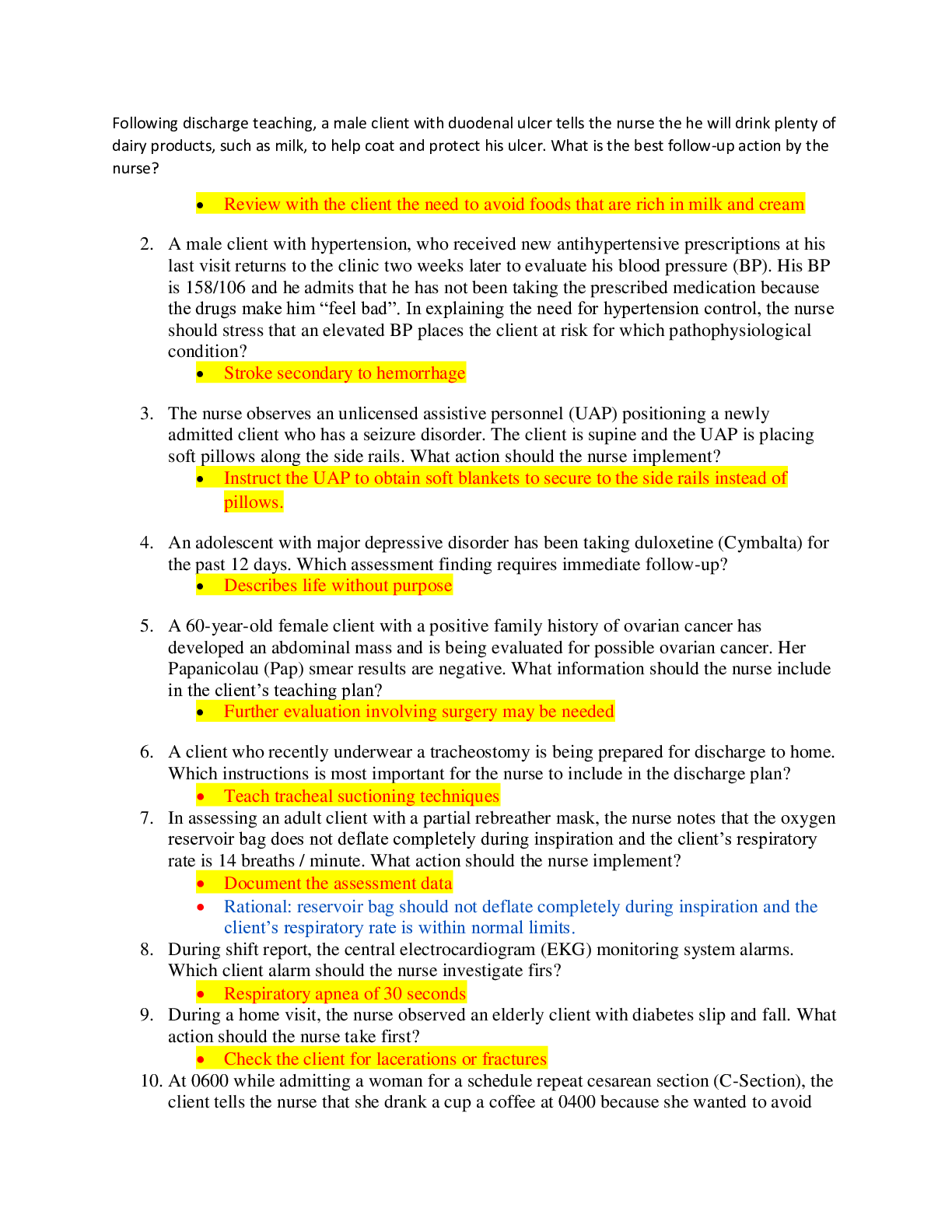*NURSING > EXAM > NU341 Unit 4 Assignment Worksheet Winningham’s Critical Thinking Cases in Nursing: Case Study 76: (All)
NU341 Unit 4 Assignment Worksheet Winningham’s Critical Thinking Cases in Nursing: Case Study 76: “Endocrine Disorders
Document Content and Description Below
NU341 Unit 4 Assignment Worksheet Winningham’s Critical Thinking Cases in Nursing: Case Study 76: “Endocrine Disorders NU341 Unit 4 Assignment Worksheet Winningham’s Critical ... Thinking Cases in Nursing: Case Study 76: “Endocrine Disorders” Scenario: Y.L., a 34-year-old Southern Asian Woman, comes to the clinic with complaints of chronic fatigue, increased thirst, constant hunger, and frequent urination. She denies any pain, burning, or low-back pain on urination. She tells you she has a vaginal yeast infection that she has treated numerous times with over-the-counter medication. She works full time as a clerk in a loan company and states she has difficulty reading numbers and reports, resulting in her making frequent mistakes. She says, “By the time I get home and make supper for my family, then put my child to bed, I am too tired to exercise.” She reports her feet hurt; they often “burn or feel like there are pins in them.” She has a history of gestational diabetes and reports that after her delivery she went back to her traditional eating pattern, which is high in carbohydrates. In reviewing Y.L.’s chart, you note she last saw the provider 6 years ago after the delivery of her last child. She gained considerable weight; her current weight is 173 pounds. Today her blood pressure (BP) is 152/97mm Hg, and a random plasma glucose level is 291 mg/dL. The provider suspects that Y.L. has developed type 2 diabetes mellitus (DM) and orders the laboratory studies shown in the chart. Chart View Laboratory Test Results: Fasting glucose 184 mg/dL Hemoglobin A1c (HbA1c) 8.8% Total cholesterol 256 mg/dL Triglycerides 346 mg/dL Low-density lipoprotein (LDL) 155mg/dL High-density lipoprotein (HDL) 32 mg/dL Urinalysis (UA) +glucose, -ketones Answer the following questions and statements. 1 ● Each question is assigned a point value. ● Submit the completed worksheet to the Dropbox no later than Day 7 of Unit 4. ● Your instructor will post the grade for this Assignment in the Gradebook no later than Day 7 of Unit 5. 1. Interpret Y.L.’s laboratory results. (4 points) 2. Identify the three methods used to diagnose DM. (6 points) 3. Describe the functions of insulin. (4 point) 4. escribe the major pathophysiologic difference between type 1 and type 2 DM. (6 points 5. Name six risk factors for type 2 DM. Place a star or asterisk next to those that Y.L. exhibits. (8 points) Scenario progresses: Y.L. is diagnosed with type 2 DM. The provider starts her on metformin (Glucophage) 500 mg and glipizide (Glucotrol) 5 mg orally each day at breakfast and atorvastatin (Lipitor) 20 mg orally 3 at bedtime. She is referred to the dietitian for instructions on starting a 1200-calorie diet using an exchange system to facilitate weight loss and lower blood glucose, cholesterol, and triglyceride levels. You are to provide education regarding pharmacotherapy and exercise. 6. How can you incorporate Y.L.’s cultural preferences as you develop her education plan? (5 points) 7. What is the rationale for starting Y.L. on metformin (Glucophage) and glipizide (Glucotrol)? (4 points) 8. Outline the teaching you need to provide to Y.L. regarding oral hypoglycemic therapy. (5 points) 9. What benefits should Y.L. receive from encouragement to exercise? (5 points) Scenario progresses: Y.L. comments, “I’ve heard many people with diabetes lose their toes or even their feet.” You take this opportunity to teach her about neuropathy and foot care. 10. Which of the symptoms that Y.L. reported today led you to believe she has some form of neuropathy? (5 points) Ackley, B. J., & Ladwig, G. B. (2014). Nursing Diagnosis Handbook: An Evidence-Based Guide to Planning Care (10th ed.). Maryland Heights, Missouri: Mosby Elsevier. Broyles, B. E., Reiss, B., & Evans, M. (2007). Pharmacological Aspects of Nursing Care (7th). Clifton Park: Delmar. Deglin, J. H., Vallerand Hazard, A., & Sanoski, C. A. (2015). Davis's Drug Guide for Nurses (14th ed.). philadelphia: F.A. Davis Company. Huether, S. E., & McCance, K. L. (2014). Understanding Pathophysiology (5th ed.). St. Louis: Elsevier Mosby. Pagana, K. D., & Pagana, T. J. (2013). Mosby's Diagnostic & Laboratory Test Reference (11 ed.). St. Louis: Elsevier, Mosby. 11. What other findings in Y.L.’s history place her at increased risk for developing neuropathy? (4 points) 12. What would you teach Y.L. about neuropathy? (5 points) 13. Because Y.L. has symptoms of neuropathy, placing her at risk for foot complications, you realize you need to instruct her on proper foot care. Outline what you will include when teaching her about proper diabetic foot care. (5 points) 14. What monitoring will Y.L. need regarding nephropathy and retinopathy? (4 points) 8 9 [Show More]
Last updated: 2 years ago
Preview 1 out of 9 pages

Buy this document to get the full access instantly
Instant Download Access after purchase
Buy NowInstant download
We Accept:

Reviews( 0 )
$8.50
Can't find what you want? Try our AI powered Search
Document information
Connected school, study & course
About the document
Uploaded On
Aug 09, 2021
Number of pages
9
Written in
Additional information
This document has been written for:
Uploaded
Aug 09, 2021
Downloads
0
Views
89

.png)






.png)





 (1).png)
 (1) (1).png)

